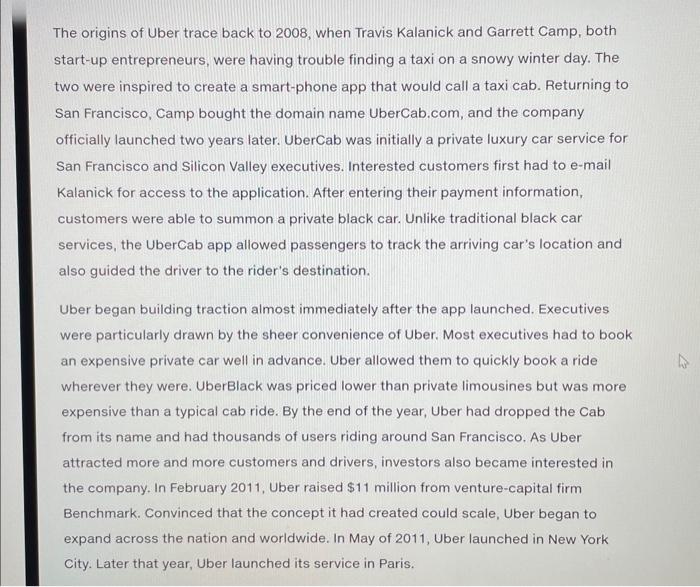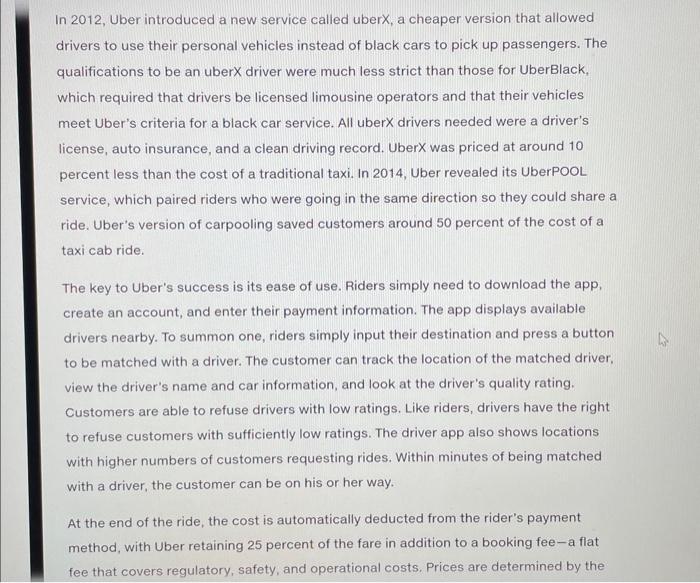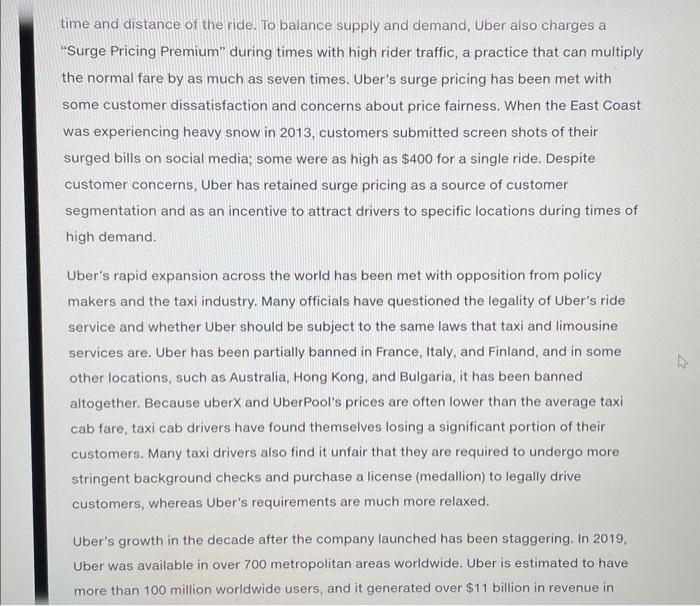The origins of Uber trace back to 2008, when Travis Kalanick and Garrett Camp, both start-up entrepreneurs, were having trouble finding a taxi on a snowy winter day. The two were inspired to create a smart-phone app that would call a taxi cab. Returning to San Francisco, Camp bought the domain name UberCab.com, and the company officially launched two years later. UberCab was initially a private luxury car service for San Francisco and Silicon Valley executives. Interested customers first had to e-mail Kalanick for access to the application. After entering their payment information, customers were able to summon a private black car. Unlike traditional black car services, the UberCab app allowed passengers to track the arriving car's location and also guided the driver to the rider's destination. Uber began building traction almost immediately after the app launched. Executives were particularly drawn by the sheer convenience of Uber. Most executives had to book an expensive private car well in advance. Uber allowed them to quickly book a ride wherever they were. UberBlack was priced lower than private limousines but was more expensive than a typical cab ride. By the end of the year, Uber had dropped the Cab from its name and had thousands of users riding around San Francisco. As Uber attracted more and more customers and drivers, investors also became interested in the company. In February 2011, Uber raised $11 million from venture-capital firm Benchmark. Convinced that the concept it had created could scale, Uber began to expand across the nation and worldwide. In May of 2011, Uber launched in New York City. Later that year, Uber launched its service in Paris. In 2012, Uber introduced a new service called uberX, a cheaper version that allowed drivers to use their personal vehicles instead of black cars to pick up passengers. The qualifications to be an uberx driver were much less strict than those for UberBlack, which required that drivers be licensed limousine operators and that their vehicles meet Uber's criteria for a black car service. All uberX drivers needed were a driver's license, auto insurance, and a clean driving record. UberX was priced at around 10 percent less than the cost of a traditional taxi. In 2014, Uber revealed its UberPOOL service, which paired riders who were going in the same direction so they could share a ride. Uber's version of carpooling saved customers around 50 percent of the cost of a taxi cab ride. The key to Uber's success is its ease of use. Riders simply need to download the app, create an account, and enter their payment information. The app displays available drivers nearby. To summon one, riders simply input their destination and press a button to be matched with a driver. The customer can track the location of the matched driver. view the driver's name and car information, and look at the driver's quality rating. Customers are able to refuse drivers with low ratings. Like riders, drivers have the right to refuse customers with sufficiently low ratings. The driver app also shows locations with higher numbers of customers requesting rides. Within minutes of being matched with a driver, the customer can be on his or her way. At the end of the ride, the cost is automatically deducted from the rider's payment method, with Uber retaining 25 percent of the fare in addition to a booking fee-a flat fee that covers regulatory, safety, and operational costs. Prices are determined by the time and distance of the ride. To balance supply and demand, Uber also charges a "Surge Pricing Premium" during times with high rider traffic, a practice that can multiply the normal fare by as much as seven times. Uber's surge pricing has been met with some customer dissatisfaction and concerns about price fairness. When the East Coast was experiencing heavy snow in 2013, customers submitted screen shots of their surged bills on social media; some were as high as $400 for a single ride. Despite customer concerns, Uber has retained surge pricing as a source of customer segmentation and as an incentive to attract drivers to specific locations during times of high demand. Uber's rapid expansion across the world has been met with opposition from policy makers and the taxi industry. Many officials have questioned the legality of Uber's ride service and whether Uber should be subject to the same laws that taxi and limousine services are. Uber has been partially banned in France, Italy, and Finland, and in some other locations, such as Australia, Hong Kong, and Bulgaria, it has been banned altogether. Because uberX and UberPool's prices are often lower than the average taxi cab fare, taxi cab drivers have found themselves losing a significant portion of their customers. Many taxi drivers also find it unfair that they are required to undergo more stringent background checks and purchase a license (medallion) to legally drive customers, whereas Uber's requirements are much more relaxed. Uber's growth in the decade after the company launched has been staggering. In 2019, Uber was available in over 700 metropolitan areas worldwide. Uber is estimated to have more than 100 million worldwide users, and it generated over $11 billion in revenue in customers. Many taxi drivers also find it unfair that they are required to undergo more stringent background checks and purchase a license (medallion) to legally drive customers, whereas Uber's requirements are much more relaxed. Uber's growth in the decade after the company launched has been staggering. In 2019 , Uber was available in over 700 metropolitan areas worldwide. Uber is estimated to have more than 100 million worldwide users, and it generated over $11 billion in revenue in 2018. Uber's combination of convenience and fair pricing has completely transformed transportation across the world. In addition to car ridesharing, Uber has branched off into food delivery service with the creation of UberEATS. The company has also announced plans to introduce an aerial ridesharing service called Uber Elevate. 63 Questions 1. What were the key factors that contributed to Uber's phenomenal market success? 2. What was Uber's customer value proposition? What role did Uber's pricing play in its ability to attract riders? 3. Is surge pricing fair? What alternative strategies could Uber use to balance supply and demand










